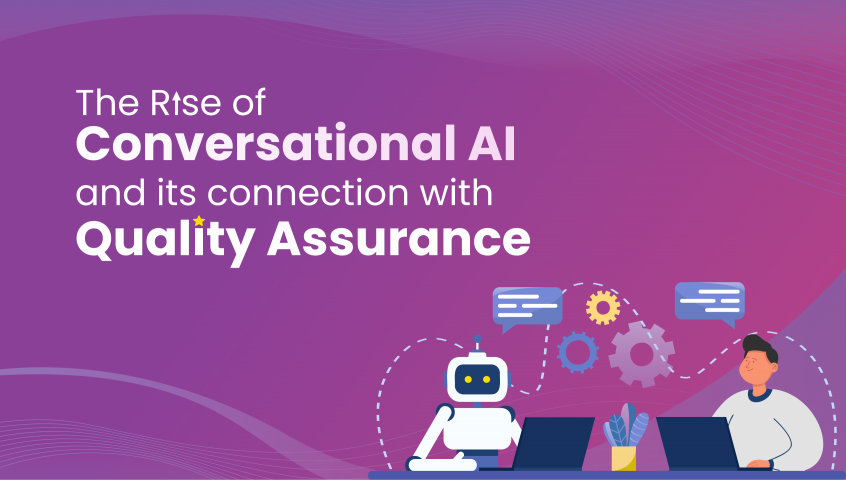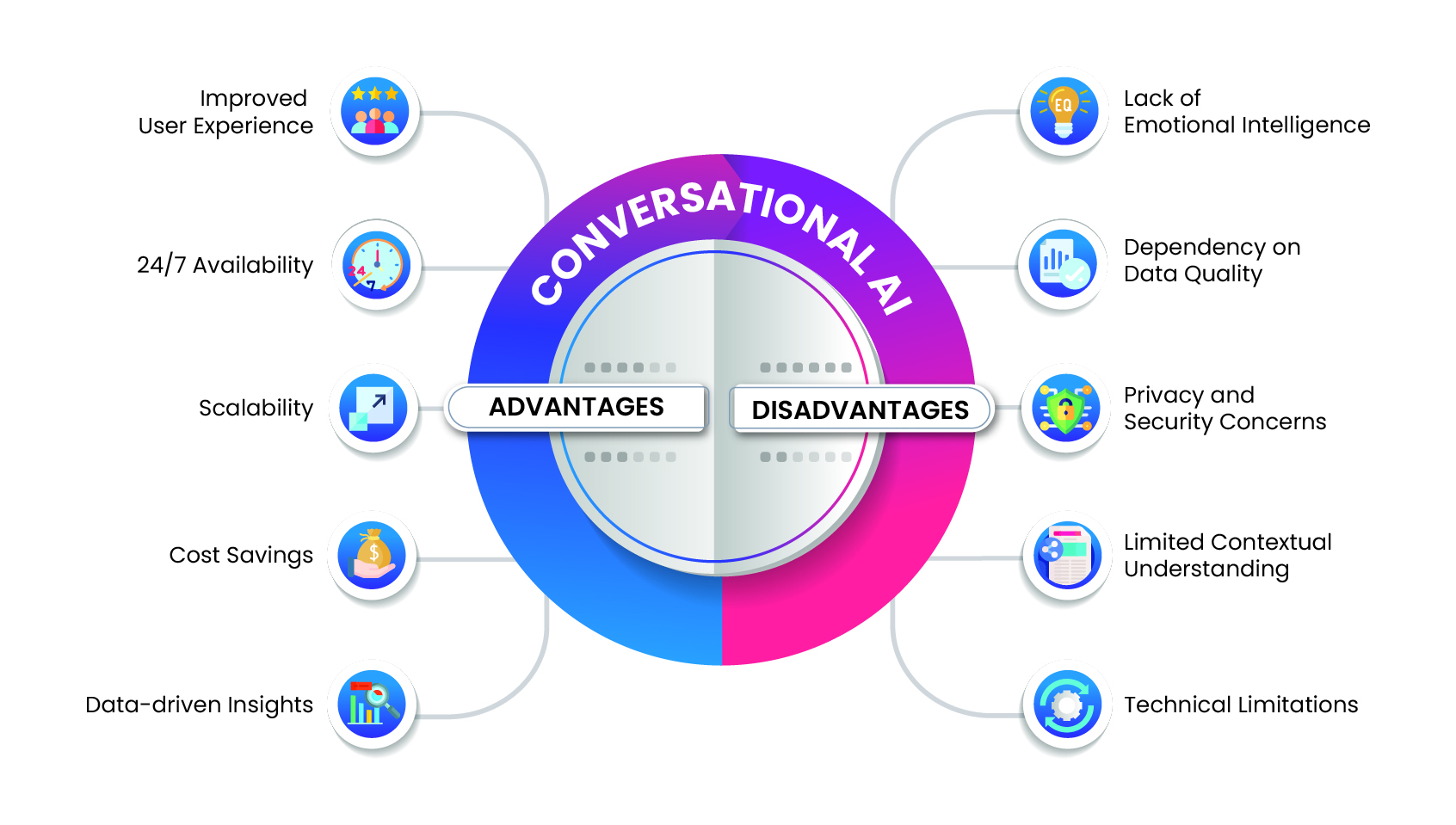
In the constantly evolving world we live in, where we see new technologies coming and going, some last and create a revolution while others fade into the night. Artificial Intelligence or AI, which has been here for some time, has now occupied the stage and is taking the world by storm. There’s no one who hasn’t heard of the new buzzword that is AI. From LinkedIn polls to WhatsApp forwards, AI has become ubiquitous and we can easily name ChatGPT the player of the series this year.
The increasing demand for conversational AI models has spurred significant progress in the industry, resulting in a wide range of applications. These cognitive systems, such as virtual assistants and chatbots, have fundamentally revolutionized our interactions with technology.
What is Conversational AI Platform?
Conversational AI, at its core, aims to simulate human-like conversations and provide users with natural and interactive interactions with machines. It combines AI techniques, such as NLP, machine learning, and speech recognition, to understand and reply to human inputs naturally. The success of conversational AI systems hinges on their ability to interpret user intent accurately, provide relevant information, and deliver a human-like conversational experience.

Conversational AI systems can be found in various applications such as chatbots, virtual assistants, voice-controlled devices, customer support systems, and more. The rise of conversational AI brings forth the need for effective quality assurance (QA) practices to ensure seamless and reliable user experiences. QA plays a pivotal role in the development, testing, and deployment of conversational AI systems.
Role of QA in Conversational AI
The role of Quality Assurance (QA) is to ensure accuracy, reliability, and overall performance of conversational AI systems. QA professionals are responsible for testing and validating Conversational AI systems to identify and rectify any issues, such as misinterpretations, incomplete responses, or errors. They also play a crucial role in improving user satisfaction by understanding user expectations and preferences through user-centric testing methodologies.
Training Data and Model Validation:
QA begins with ensuring the quality and relevance of the training data used to develop conversational AI models. This includes data collection, cleaning, and annotation to enhance the accuracy and diversity of the training set. QA professionals validate the training data to ensure it represents real-world user scenarios and covers a wide range of potential queries and intents.
Intent Recognition and Response Accuracy:
A crucial aspect of conversational AI is accurate intent recognition, where the system understands the user's purpose or query. QA teams validate the intent classification models by testing them with various inputs to ensure accurate recognition. They also assess the response generation capabilities to ensure the system provides relevant and coherent answers.
Natural Language Understanding (NLU) Testing:
NLU testing focuses on evaluating how well the conversational AI system comprehends and interprets user input. QA professionals design test cases to cover different language patterns, user intents, and edge cases. This helps identify areas of improvement in NLU models and fine-tune them for better performance.
Speech Recognition and Voice Interaction:
For voice-enabled conversational AI, QA includes testing the accuracy and reliability of speech recognition systems. This involves assessing the system's ability to understand spoken commands and accurately transcribe them into text. QA professionals verify voice interactions across different devices, environments, and accents to ensure a seamless experience for users.
Dialog Flow and Contextual Understanding:
Conversational AI should be capable of maintaining contextual understanding throughout a conversation. QA teams validate the dialog flow and context management capabilities of the system, ensuring smooth transitions between user turns, maintaining context across multiple queries, and providing coherent responses.
System Integration and Compatibility:
QA plays a critical role in testing the integration of conversational AI systems with various platforms, applications, and backend systems. Compatibility testing ensures that the system functions seamlessly within the target environment, adheres to security protocols, and integrates well with other components or APIs.
Continuous Monitoring and Feedback Loop:
QA efforts don't end with the deployment of conversational AI systems. Continuous monitoring and feedback collection are essential to identify performance degradation, address user feedback, and refine the system over time. QA teams leverage user feedback, sentiment analysis, and analytics to drive continuous improvement and enhance user satisfaction.
Multimodal Conversational AI:
With advancements in technology, Conversational AI systems are now capable of processing and responding to multiple modes of communication, including voice, text, and visual inputs. QA in Conversational AI is adapting to test and validate these multimodal capabilities for seamless user experiences.
Contextual Understanding:
Conversational AI systems are becoming more contextually aware, considering the user's previous interactions and information to provide more personalized and relevant responses. QA teams focus on validating the system's contextual understanding and ensuring accurate and contextually appropriate responses.
Sentiment Analysis:
Sentiment analysis is gaining prominence in Conversational AI. QA professionals leverage sentiment analysis techniques to assess user sentiment and emotional responses, enabling Conversational AI systems to respond empathetically and appropriately to user inputs.
What tools are being used in the market for Quality Assurance?
Several tools and platforms are available to support Conversational AI QA processes.
Botpress: An open-source conversational AI platform that provides tools for building, testing, and deploying chatbots. It offers features for training and testing conversational models and analyzing user interactions.
Dialogflow: Dialogflow is a powerful tool for quality assurance (QA) of AI models. It enables QA teams to generate test cases, validate intent recognition, test entity recognition accuracy, evaluate performance and accuracy, and conduct regression testing. By leveraging Dialogflow's conversational interface and natural language understanding capabilities, QA professionals can thoroughly assess the functionality, accuracy, and performance of AI models, ensuring their quality and reliability.
IBM Watson Assistant: It is a virtual assistant platform that utilizes AI technology, empowering developers to build and implement conversational agents. This platform provides developers with a range of tools to create, test, and refine the responses and behavior of the virtual assistant.
Microsoft Bot Framework: The Microsoft Bot Framework is a flexible platform created to build and deploy conversational agents on different communication channels. It includes a set of tools that aid in testing, debugging, and monitoring the performance of bots.
Amazon Lex: Amazon Lex is a service by Amazon Web Services (AWS) that allows developers to build conversational interfaces using voice and text. It offers tools for testing and validating conversational models and integrates with other AWS services for enhanced functionality.
These tools, among others, provide developers and QA professionals with the necessary resources to create, test, and deploy Conversational AI systems while ensuring their quality and performance.
Use Cases of Conversational AI
Customer Support Chatbots: Many companies use conversational chatbots on their websites or messaging platforms to handle customer inquiries and provide instant support. These chatbots possess the capability to comprehend and address customer inquiries, offer pertinent information, and if needed, escalate concerns to human agents.
Virtual Assistants: Virtual assistants like Apple's Siri, Google Assistant, Amazon's Alexa, and Microsoft's Cortana are prime examples of Conversational AI. These virtual assistants have the ability to comprehend voice commands and carry out various tasks, including setting reminders, providing answers to questions, playing music, and managing smart home devices.
Voice-Enabled Navigation Systems: Voice-enabled navigation systems, like those found in vehicles or on mobile devices, use Conversational AI to provide turn-by-turn directions, traffic updates, and other location-based services. By utilizing voice commands, users can engage with the system, enhancing safety and convenience, especially during travel or while on the road.
Language Learning Apps: Conversational AI is employed in language learning applications to simulate conversations with virtual language tutors. These applications help learners practice speaking in a foreign language by providing feedback, corrections, and personalized learning experiences.
Appointment Scheduling: Conversational AI-powered appointment scheduling systems enable users to book appointments or make reservations through natural language conversations. These systems understand user preferences, availability, and specific requirements, making the process seamless and efficient.

Future Trends that will impact Conversational AI
With the continuous advancement in AI and machine learning technologies, the future of conversational AI is very promising. We can expect to see the development of more sophisticated conversational agents capable of understanding and responding to complex queries with more context awareness.
AI chatbots keep learning and getting better at understanding and responding to more complex user queries. They learn to understand different ways people express themselves and become better at matching questions with suitable answers.
Research and development efforts are focused on imbuing chatbots with emotional intelligence to understand and respond empathetically to users' emotions and needs, creating more human-like interactions.
Another phenomenon in process is chatbots incorporating multiple modes of communication, such as text, voice, images, and even gestures, to provide more interactive and versatile conversational experiences.
Furthermore, with the increasing adoption of voice technology, voice-based conversational AI will likely see significant growth. This will necessitate more rigorous QA processes for voice recognition and understanding, especially considering the diversity of accents and dialects.
Challenges QA encounters while working with Conversational AI
While conversational AI has tremendous potential, there are several challenges in implementing quality assurance for these systems:
- Lack of Emotional Intelligence: Despite advances in sentiment analysis, conversational AI systems often struggle to understand and respond appropriately to users' emotional states. To overcome this, QA professionals must work closely with developers to create more robust models of human emotion and train the AI systems accordingly.
- Dependency on Data Quality: The effectiveness of conversational AI heavily depends on the quality of training data. This means that if the data is biased, inaccurate, or incomplete, it can significantly impact the performance of the AI system. QA teams need to implement rigorous data validation and cleaning processes to ensure the quality of training data.
- Privacy and Security Concerns: As conversational AI gains widespread adoption, collecting vast amounts of user data, concerns around privacy, data security, and ethical use of personal information are emerging, leading to increased emphasis on building trustworthy and transparent conversational systems. QA professionals need to implement robust security testing processes to identify and mitigate potential vulnerabilities.
Ethics and biases: When it comes to conversational AI, ethics can indeed be a significant challenge. Chatbots learn from vast amounts of data, including potentially biased or discriminatory content. Consequently, biased or unfair responses can emerge, inadvertently reinforcing prevailing social biases. To ensure equitable and fair interactions, developers must proactively tackle and alleviate biases.
Conversational AI can be exploited to spread misinformation, propaganda, or engage in malicious activities like phishing or scamming. It can also influence or persuade users for commercial or political purposes. Efforts must be made to detect and prevent such misuse, protecting users from misinformation and manipulation.
Effectively addressing these ethical challenges necessitates a collective endeavor involving developers, researchers, policymakers, and other stakeholders working collaboratively. Guidelines, frameworks, and regulations are being developed to promote responsible and ethical practices in the design, deployment, and use of conversational AI systems, fostering trust and ensuring positive societal impact.
In the era of AI and Machine Learning, the influence of QA goes beyond mere testing, extending into the realms of accuracy, reliability, user satisfaction, compliance, and performance optimization. QA professionals are instrumental in shaping Conversational AI systems to meet the evolving expectations of users and organizations. Their meticulous efforts, continuous monitoring, and optimization contribute significantly to the success and widespread adoption of Conversational AI solutions.
The Conversational AI market has been encountering noticeable growth and is projected to continue expanding in the coming years. According to ReportLinker, the global conversational AI market grew from $7.86 billion in 2022 to $9.73 billion in 2023 at a compound annual growth rate (CAGR) of 23.8% and is expected to grow to $22.07 billion in 2027. As this technology continues to mature, the role of QA in ensuring seamless functioning and user satisfaction will only grow in importance.
Drop us an email at info@qentelli.com and find out how to leverage AI for your business. We have an Innovation practice that focuses on AI Solutions and their applicability to real world problems.

